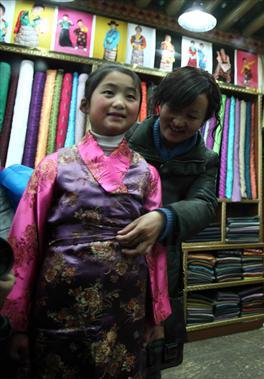Tibetans start New Year celebrations
 |
|
A Tibetan girl tries on a traditional dress in Lhasa on Friday ahead of the region's new year celebrations. |
Business was booming on Friday at Barkhor Bazaar, one of the most famous markets in Tibet, as hordes of shoppers geared up to celebrate the Tibetan Losar new year.
Despite March traditionally being a slow month for traders in Lhasa, capital of the autonomous region, stalls have been swamped ahead of celebrations to welcome the Year of the Iron Rabbit, which starts on Saturday.
"Business has improved in recent years because there are more tourists," said Barkhor Bazaar storeowner Abdulnahim Muslim, a Nepali who arrived in Tibet 19 years ago.
"Tibetan new year is also a good time for me," he said, adding that his Nepali and Indian perfumes were selling pretty well.
Although the popularity of imported goods is increasing, traditional new year products have still proved seasonal favorites.
At Tson Se Kang market, where Tibetan families shop for new year necessities, most lists included highland barley grown in small garden pots.
Colorful sheep head sculptures, another must-have, symbolize prosperous animal husbandry, with the pronunciation of "sheep head" in Tibetan similar to that for "start of a year".
Delicate qiema - wooden compartment boxes - are always present at important Tibetan ceremonies. For Losar new year, Tibetans fill them with wheat and a type of bread called tsamba, and then stick in colorful ears of wheat and butter sculptures.
Just west from Tson Se Kang market is the crowded Beijing East Road, where several shops selling traditional Tibetan
clothes were welcoming last-minute buyers.
"Now is the time to show off, as you can tell how wealthy a family is from the clothes and decorations they wear on New Year's Day," said Wang Shuxia, head of Caigongtang county in eastern Lhasa.
Traditional Tibetan families are large - Wang's county, for example, has 1,437 households composed of 5,049 members - and, like Spring Festival, Losar new year is a time for reunions.
Gyari, 53, who lives in a village in Caigongtang, said that on Thursday his entire family (barring his youngest son, who is serving in the army) gathered for gutu, which is eaten just before new year.
Gutu are little pastries boiled in beef and vegetable soup. Wrapped inside are things like choma, which is a sweet tasting root, wool, salt, wheat, chili, pieces of china, charcoal and black beans.
Each ingredient represents a different fate in the coming year.
The pastries are cooked together and served randomly, with each person revealing what awaits them.
Gyari was the luckiest as he got choma, which means he will face no problems in the coming year. (One China Daily reporter received a piece of china, which means they care more about food than work.)
Lhapa Tsering, Party secretary of Gyari's village, said that gutu is an old tradition, with "gu" meaning nine and "tu" meaning pastries.
"In ancient times, each person had to eat nine pastries so as to leave all the bad things in the past," he explained.
"Now, many young people don't know how to make gutu," he added. "Most of the time it's the elders in the family who make it."
 0
0 







Go to Forum >>0 Comments